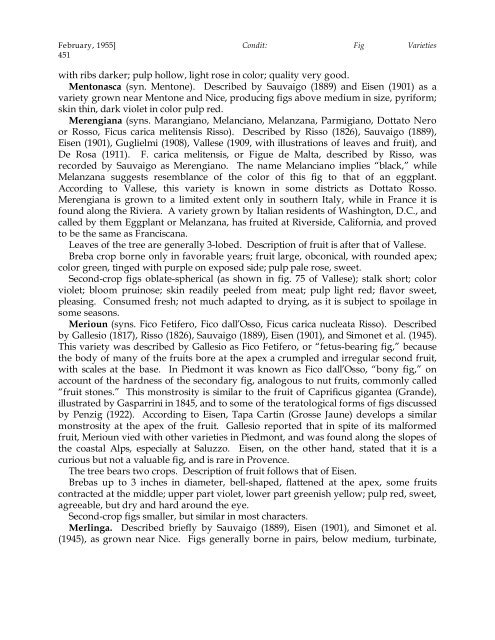Fig Varieties: A Monograph - uri=ucce.ucdavis
Fig Varieties: A Monograph - uri=ucce.ucdavis
Fig Varieties: A Monograph - uri=ucce.ucdavis
You also want an ePaper? Increase the reach of your titles
YUMPU automatically turns print PDFs into web optimized ePapers that Google loves.
February, 1955] Condit: <strong>Fig</strong> <strong>Varieties</strong><br />
451<br />
with ribs darker; pulp hollow, light rose in color; quality very good.<br />
Mentonasca (syn. Mentone). Described by Sauvaigo (1889) and Eisen (1901) as a<br />
variety grown near Mentone and Nice, producing figs above medium in size, pyriform;<br />
skin thin, dark violet in color pulp red.<br />
Merengiana (syns. Marangiano, Melanciano, Melanzana, Parmigiano, Dottato Nero<br />
or Rosso, Ficus carica melitensis Risso). Described by Risso (1826), Sauvaigo (1889),<br />
Eisen (1901), Guglielmi (1908), Vallese (1909, with illustrations of leaves and fruit), and<br />
De Rosa (1911). F. carica melitensis, or <strong>Fig</strong>ue de Malta, described by Risso, was<br />
recorded by Sauvaigo as Merengiano. The name Melanciano implies “black,” while<br />
Melanzana suggests resemblance of the color of this fig to that of an eggplant.<br />
According to Vallese, this variety is known in some districts as Dottato Rosso.<br />
Merengiana is grown to a limited extent only in southern Italy, while in France it is<br />
found along the Riviera. A variety grown by Italian residents of Washington, D.C., and<br />
called by them Eggplant or Melanzana, has fruited at Riverside, California, and proved<br />
to be the same as Franciscana.<br />
Leaves of the tree are generally 3-lobed. Description of fruit is after that of Vallese.<br />
Breba crop borne only in favorable years; fruit large, obconical, with rounded apex;<br />
color green, tinged with purple on exposed side; pulp pale rose, sweet.<br />
Second-crop figs oblate-spherical (as shown in fig. 75 of Vallese); stalk short; color<br />
violet; bloom pruinose; skin readily peeled from meat; pulp light red; flavor sweet,<br />
pleasing. Consumed fresh; not much adapted to drying, as it is subject to spoilage in<br />
some seasons.<br />
Merioun (syns. Fico Fetifero, Fico dall’Osso, Ficus carica nucleata Risso). Described<br />
by Gallesio (1817), Risso (1826), Sauvaigo (1889), Eisen (1901), and Simonet et al. (1945).<br />
This variety was described by Gallesio as Fico Fetifero, or “fetus-bearing fig,” because<br />
the body of many of the fruits bore at the apex a crumpled and irregular second fruit,<br />
with scales at the base. In Piedmont it was known as Fico dall’Osso, “bony fig,” on<br />
account of the hardness of the secondary fig, analogous to nut fruits, commonly called<br />
“fruit stones.” This monstrosity is similar to the fruit of Caprificus gigantea (Grande),<br />
illustrated by Gasparrini in 1845, and to some of the teratological forms of figs discussed<br />
by Penzig (1922). According to Eisen, Tapa Cartin (Grosse Jaune) develops a similar<br />
monstrosity at the apex of the fruit. Gallesio reported that in spite of its malformed<br />
fruit, Merioun vied with other varieties in Piedmont, and was found along the slopes of<br />
the coastal Alps, especially at Saluzzo. Eisen, on the other hand, stated that it is a<br />
curious but not a valuable fig, and is rare in Provence.<br />
The tree bears two crops. Description of fruit follows that of Eisen.<br />
Brebas up to 3 inches in diameter, bell-shaped, flattened at the apex, some fruits<br />
contracted at the middle; upper part violet, lower part greenish yellow; pulp red, sweet,<br />
agreeable, but dry and hard around the eye.<br />
Second-crop figs smaller, but similar in most characters.<br />
Merlinga. Described briefly by Sauvaigo (1889), Eisen (1901), and Simonet et al.<br />
(1945), as grown near Nice. <strong>Fig</strong>s generally borne in pairs, below medium, turbinate,
















![Fig Trees in North Carolina [Archive] - IDigMyGarden ... - Figs 4 Fun](https://img.yumpu.com/26905320/1/190x245/fig-trees-in-north-carolina-archive-idigmygarden-figs-4-fun.jpg?quality=85)